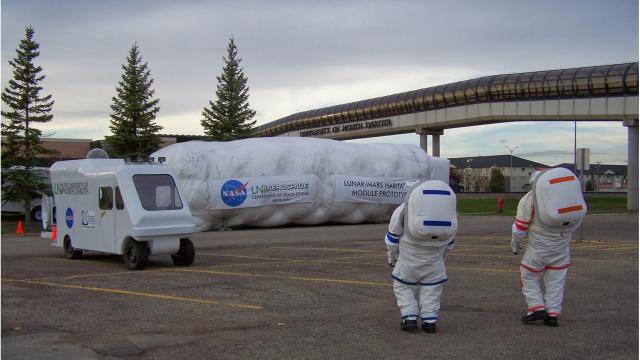Humans will make outer space dirty.
One small step through the parking lot (Image: Blachowicz et al, Microbiome (2017))
NASA puts a lot of effort into keeping space clean. The Office of Planetary Protection, for example, exists to protect the Earth from potential life on other planets — but they also have to protect other planets from us. So it’s important to know exactly how we impact the environments we intrude on.
A team of NASA researchers is trying to recreate the environment on the space station to see exactly how humans impact what microorganisms colonise space habitats. In their most recent research, they measured how the kinds of fungi changed as humans lived in an inflatable habitat. Despite only four human occupants, it was clear that the mere presence of people changed the kinds of species that took up residence. That will be especially important to know when people actually live in these habitats in space.
“We carry more microbes than human cells,” study author Dr Kasthuri Venkateswaran from the Planetary Protection Group at NASA’s Jet Propulsion Laboratory told Gizmodo. “We need to take care of what’s being transported to other places.”
The four “astronauts” took residence in a 12m by 10m by 2.5m habitat in North Dakota which contains a kitchen, lab, toilet and bedroom. Missions inside last up to 30 days, during which the only thing brought in from the outside world are humans and filtered air. Fungus samples were taken in each of the rooms on four separate times during a 30 day, four-person mission: On day 0, 13, 20 and 30.
The results of the sampling were nuanced: There were fewer overall fungi in the habitat at the end of the mission, but an increase in certain kinds, namely the genuses Epiccocum, Alternaria, Pleosporales, Davidiella and Cryptococcus. The researchers published their results today in the journal Microbiome.
This study only tracks changes in the hab due to four different people, so it’s certainly a small sample size. But the results validate the researchers’ past work. They have done similar studies on bacterial diversity, and it’s clear that the microbial makeup of these closed habitats takes on the flavour of the tiny species humans bring with them. And researchers will perform followup studies on other habitats for longer periods of time, said Venkateswaran.
But these initial findings are important, he said. Scientists need to understand the changes in the microbial environment to ensure it’s safe for the astronaut’s immune systems — they’re certainly never going to live in sterile environments, and NASA is concerned about microbes becoming more pathogenic in space. In this case, Alternaria can potentially be harmful to humans. Venkateswaran told Gizmodo: “We need to develop strategies to measure the pathogenic and problematic fungi.”
